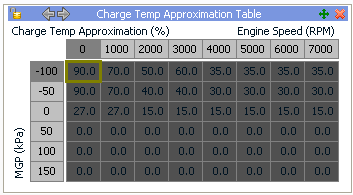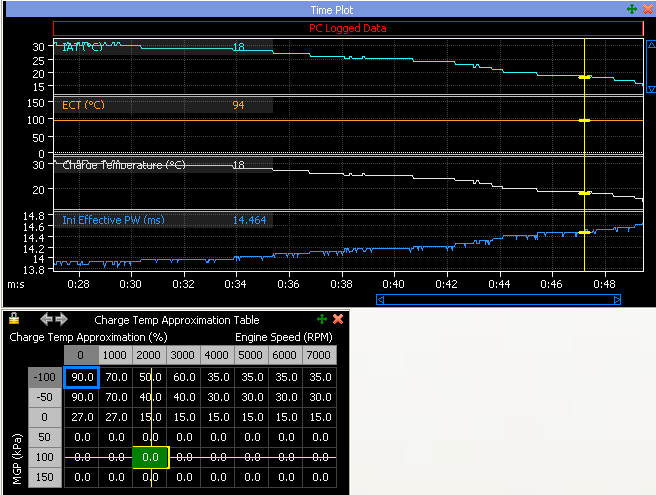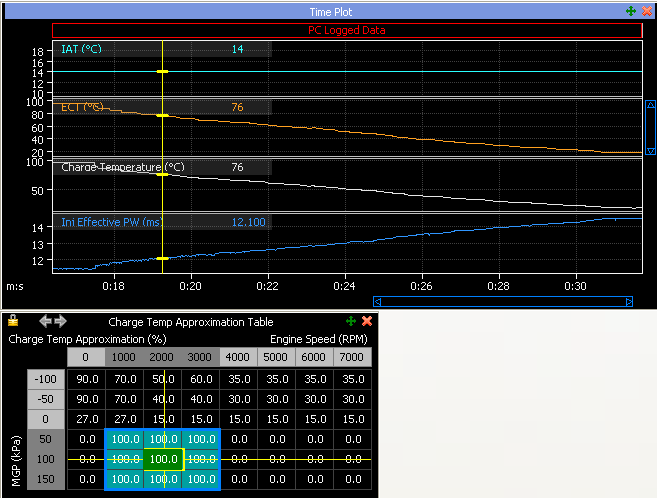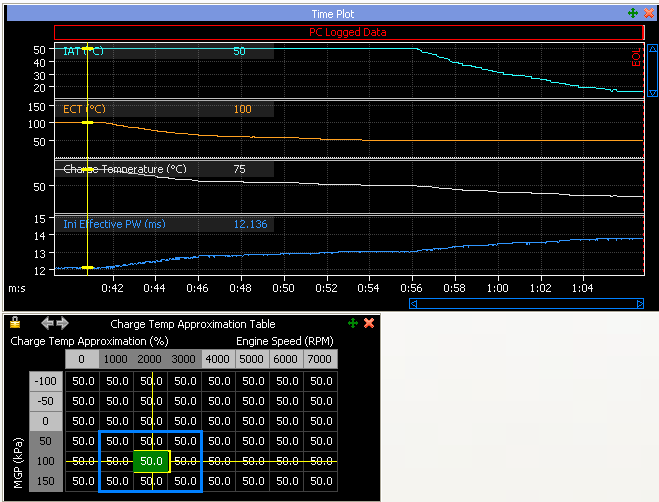Charge Temperature refers to the temperature of the air entering the engines intake port. This value can be estimated from the Engine Coolant Temperature (ECT) and Intake Air Temperature (IAT) parameters at various load points.
The influence of IAT and ECT upon the current Charge Temperature value is affected by the current value from the Charge Temp Correction Table.

A table value of 100% means the Charge Temperature parameter will read the same as the ECT parameter.
A table value of 0% means the Charge Temperature parameter will read the same as the IAT parameter.
In Traditional Fuel Equation Mode, Charge Temperature Correction must be turned on if it is to be used. In Modelled and Modelled - Multi Fuel modes Charge Temperature Correction is always used and there is no On/Off setting available.
WARNING: Manifold temperature sensor location has a large influence on accurate charge temperature estimation. Placing a sensor before the throttle body may not provide an accurate indication of the temperature of the air drawn into the cylinder. A sensor placed in the manifold may be more accurate. A heat soaked manifold will increase the temperature of the intake air charge significantly. It is important that the sensor type used is fast responding and has an element that is out in the air flow.
Setup Notes
·Generally speaking, the more airflow the engine has, the more influence IAT should have. This should lead to a table that has lower values as the MGP and Engine Speed increase.
·Charge Temperature Correction uses the IAT and ECT sensor data, but does not require use of the separate IAT and Warm-up (ECT) enrichment functions.
·When using the Charge Temp Correction, start with IAT Fuel Correction set to Off (or all zero) and set the Warm-up Enrichment table so all values are zero. Now setup the Charge Temperature Correction table. If you are unable to achieve enough correction or want additional correction use the IAT Fuel Correction and Warm-up Enrichment table also.
·IAT sensor location and type can cause substantial differences in the table. This is due primarily to heat-soak.
·If only charge temperature estimation from the intake manifold temperature sensor is required, set the table value to all 0.
Charge Temp Table Approximation Numbers
The following examples are to help understand how Charge Temperature Correction works. In the examples the Warm-up Enrichment table cells are all set to zero and IAT Fuel Correction is turned OFF.
·When the active cell from the Charge Temp Approximation Table is set to 0.0

As can be seen in the image above, the Charge Temperature value tracks the IAT value. You can also see that as the Charge Temperature decreases, the injection effective pulse-width increases. This is because as the Charge Temperature decreases the density of the air increases and more fuel is required.
·When the active cell from the Charge Temp Approximation Table is set to 100.0

As can be seen in the image above, the Charge Temperature value tracks the ECT value.You can also see that as the Charge Temperature decreases, the injection effective pulse-width increases. This is because as the Charge Temperature decreases the density of the air increases and more fuel is required.
·When the active cell from the Charge Temp Approximation Table is set to 50.0

As can be seen in the image above, at the start of the log ECT = 100°C, IAT = 50°C, and Charge Temperature = 75°C (half way between ECT and IAT). Initially the ECT decreases and the Charge Temperature also decreases because of this, later the ECT stays stable and the IAT decreases and the Charge Temperature also decreases because of this. Because the Charge Temperature has decreased, the density of the air has increased and the ECU adds more fuel, which can be seen by the increased effective pulse-width.
Determining Values for the Charge Temp Approximation Table
Generally speaking when less air flows through the engine the heat of the engine (ECT) will have more of a heating effect on the incoming air. And when more air flows through the engine the heat of the engine (ECT) will have less of a heating effect on the incoming air.
Normally the higher the engine speed the lower the value needed in the charge temp table. Also the higher the engine load (MGP or TPS) the lower the value needed in the charge temp table.
Logging engine data and then analysing it will help determine if the charge temp table value for a certain engine speed and load needs to be increased or decreased.
·Increasing the value example
Imagine you recorded a log and upon reviewing it you found the following:
MGP = -50 kPa
Engine speed = 2000 rpm
Charge table value = 50
Lambda target = 0.9
Lambda reading = 0.8
ECT = 40C
IAT = 20C
Charge temp = 30C
In this situation the engine requires less fuel, which means the Charge Temperature needs to be increased. To achieve this ECT needs to have more influence (as ECT is at a higher temperature than IAT), so the Charge Table value is increased from 50 to 75. Record another log and look at the result. Now adjust again as required.
·Decreasing the value example
Imagine you recorded a log and upon reviewing it you found the following:
MGP = -50 kPa
Engine speed = 2000 rpm
Charge table value = 50
Lambda target = 0.9
Lambda reading = 1.0
ECT = 40C
IAT = 20C
Charge temp = 30C
In this situation the engine requires less fuel, which means the Charge Temperature needs to be decreased. To achieve this IAT needs to have more influence (as IAT is at a lower temp than ECT), so we the Charge Table value is decreased from 50 to 25. Record another log and look at the result. Now adjust again as required.
When reviewing a log file all the cells of the Charge Table that the log has data points for (Engine Speed and Load) can be adjusted. Another log file can then be recorded and examined to see which cells of the Charge Table still needs adjusting. Each time this process is repeated each cell of the Charge Table will be getting closer to where it needs be. For cold start tuning this process may take some days, as getting the engine back down to a low ECT can take a while.


